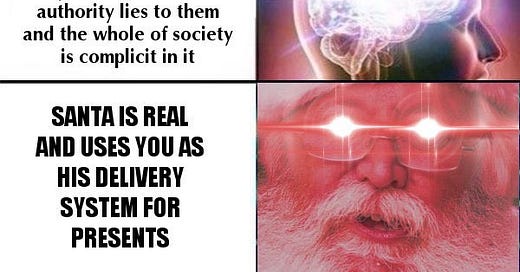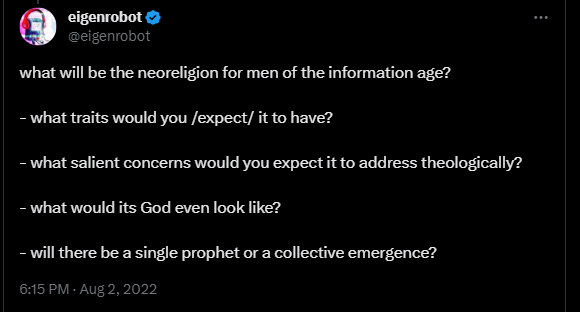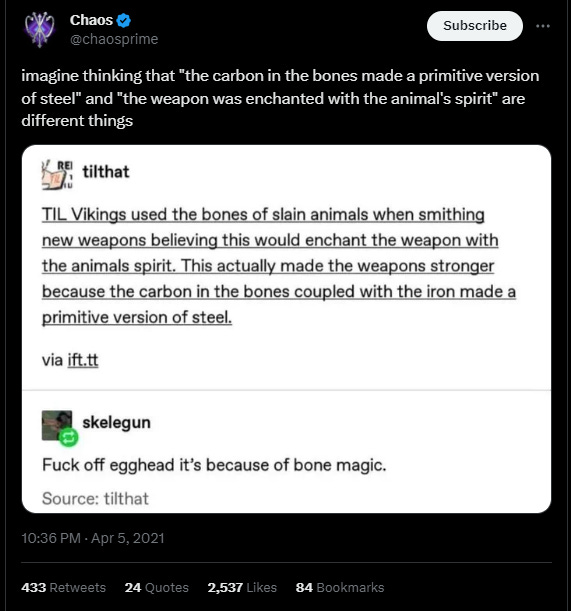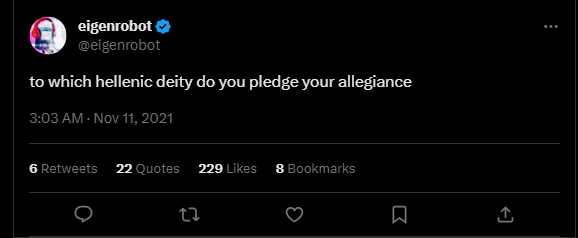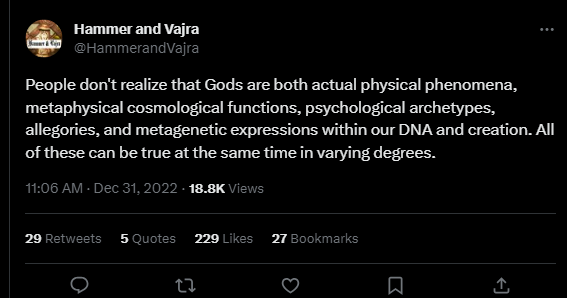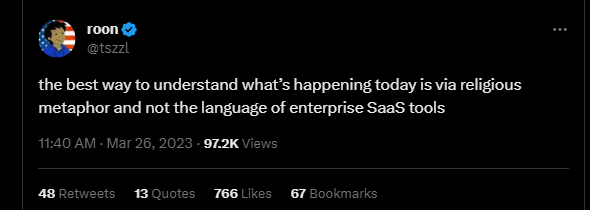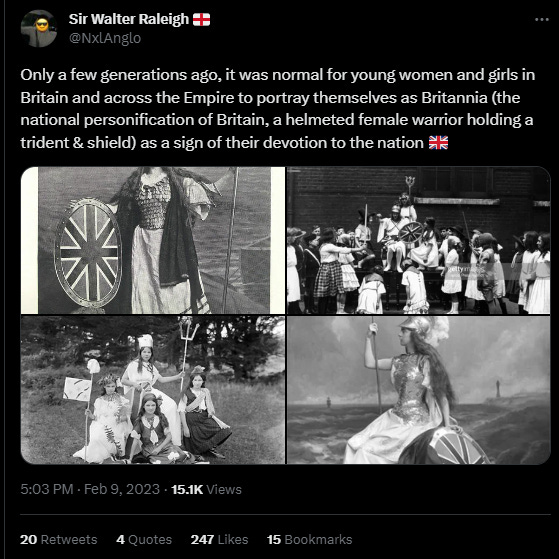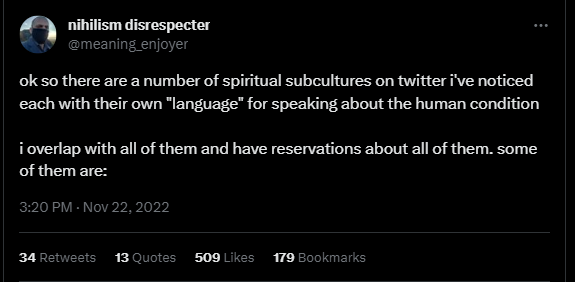You probably don't think of yourself as polytheist, animist or anything of this sort.
What if I told you that you're already one?
There's a chance you say: 'I don't actually make sacrifices to many gods'. I could defend mentioning that the term 'monolatry' is for 'worship of one', and 'monotheism' is 'stance of accepting existence of one'. But yeah, in the past it was sacrifice and going to a temple that made someone a devotee of a specific deity. So in that sense you're right... but what about the Judeo-Christian treatment of Mammon? One of the seven princes of Hell is money?!
If you've been around This Part Of Twitter you must have heard about Moloch, Egregores. If you're really deep in some even more esoteric parts you know about Elua, tulpas, thoughtforms and Syzygetic Lemurs. If this is confusing, don't be afraid, pointers to explanations will follow.
What all this means is that TPOT is the latest breeding ground for pagan thinking - that's the stage we left at the last time.
link to the post
Now this should be obvious to everyone by now, so I am making this as a reference post. The question was asked - what is the neoreligion of the information age?
https://twitter.com/eigenrobot/status/1554501197725372422?s=20
The memeplex found in TPOT is the answer, at least now. But as with other things, TPOT is likely ahead of the curve also in this.
A previous post contained an argument why we're already kind of polytheistic always. Here's why TPOT is the CUTTING EDGE of this.
And I call this memeplex "technoanimism". This post will say why, then giving examples of tweets, demonstrating the prominence of this mindset. Then a short historical background study of origins of the mindset and its predecessors.
Term technoanimism itself
Technoanimism is not a new term, it's an old thing Using the 'adding-sparks-vs-deflating' spectrum introduced in the previous post, this is definitely on the deflating side.It is one step beyond seeing technology as magic, it is seeing it as alive. It has been present for a long time in Japan, with supportive legislation even!
There has been some but miniscule presence of the term online, what I could gather is most prominent I present here: this 2017 Medium post on the online phenomenon, and a paper on this, examining Japanese technoanimism in the light of agent-network theory.
As with many other vehicles of Japanese cultural victory Shinto is spreading overseas, so maybe we could jump on this bandwagon and propagate technoanimism?
That's what I arrived at, but were there different contenders?
Other contenders
Another term, maybe closer to what TPOT is, is terminally online paganism. That is longer and less exciting, even if it is correct. It is a good description of an aspect of this whole memeplex, but ultimately it's literally opposed to any going beyond, any teleology. Therefore a label that is more conducive to development is better.
Yet another idea was 'glorious paganism' - "glorious" here would mean bold and focused on doing real stuff, such as glorious new technology. But BAP comes to mind sooner where glory is of the martial spirit and physique so that road's taken.
I also thought of 'TPOT Hermeticism' but that's kind of niche and signals exclusivity. 'Pagan' is too broad, same goes with 'polytheist', the latter which can alienate some people in the cluster.
Let's move onto the discussion of evidence that technoanimism truly is in TPOT.
Evidence in Tweets
I have a couple of tweets from my collection - will have more tbh, you get the finest selection from accounts such as @tszzl, @chaosprime and @eigenrobot.
This is a big one, an overview of distinct traditions. many language traditions
https://twitter.com/meaning_enjoyer/status/1595059720045613056
The whole internal family systems thing is not animist in the most common sense when external objects receive soul and agency, but internal ones. Also valid.
spirits are in the minds
https://twitter.com/Conaw/status/1606892916236251136
Christ as egregore
https://twitter.com/BlindMansion/status/1607207304918872064
imagine thinking that "the carbon in the bones made a primitive version of steel" and "the weapon was enchanted with the animal's spirit" are different things
https://twitter.com/chaosprime/status/1379171099024457735
tpot pledging to Hellenic deities
https://twitter.com/eigenrobot/status/1458616412704952325
This account a bit on the outskirts of tpot, much more explicitly religious than average, but still this view of gods as various things is quite resonating.
https://twitter.com/HammerandVajra/status/1609128737186152449
most overpowered psychotechnology is animism and it's not even close
https://twitter.com/the_wilderless/status/1639859367766794242
the best way to understand what's happening today is via religious metaphor and not the language of enterprise SaaS tools
https://twitter.com/tszzl/status/1639925283758436352
it is even bleeding over into vocabulary of more mainstream figures - see this video by JBP on anger and demons
That is a big picture, a collage of various angles. They definitely form a memetic cluster, but they can be split further. There are terms used for big entities, these are used for those crafting Grand Narratives, these are often quite novel. Then there's the psychological sphere - tulpas and egregores, the latter similar to the Grand Narratives but bigger in reflexivity. Then we have the Lindy use of old metaphors - such as invoking Hellenic gods. Finally we have the broad animist outlook seeing spirits in many places.
How did this come to be? In the previous post we saw the general recurrence of animist ideas across time, but not focusing on any specific lineage.
Tracing the lineage
We can limit ourselves to the last 200 years, mostly even less.
First we have the vampiric capital from Marx's first volume of Das Kapital. That meme of course persisted throughout the leftist tradition.
For balance we can see on the nationalist side traditions such as "Britannia girl personification", a thing in the 19th and 20th centuries - not really anymore.
https://twitter.com/NxlAnglo/status/1623714230905065472
Then we have the psychology school of Carl Jung, where an archetype is the thing behind things. It is so different from Freudian or behaviorist psychology.
Jumping between disciplines, geological and ecological sciences have the Gaia hypothesis - it does have its own predecessors much earlier than the 70s, but the formulation is the most known.
Techno-spirits locked in the interwebs are a thing in cyberpunk science fiction and that was one of the inspirations for the esoteric writings of Nick Land in the 90s talking about the Lemurs. Continuing the rightwing streak, in the 2008 Mencius Moldbug coined the now famous phrase of 'Cthulhu always swimming left', conceptualizing leftism as an entropy-like decay force.
All that vibe was caught on by a closeted NRx reader Scott Alexander, and we can witness this in the seminal post inaugurating the meme of 'fighting Moloch' , “Elua vs Moloch”.
Where does all of this leave us? If all these different POVs had the animist mindset we seek, what is so special about TPOT? Of course it's the fact that there's frens there, but what more? That is because of the archetypal profile of TPOT...
Hermes, the god of TPOT
Where we see Hermes' titles, prominent are: Herald of the Gods, god of merchants, thieves, orators and also a soul guide.
The archetype in the abstract is of liminal spaces, joining, merging, transitions. This caused his domain to also include sexual intercourse, shepherds, roads and hospitality and borders.
How does it relate to TPOT? After all there are many circles that relate to other deities. There is Aphrodite and Eros twitter (dating), Hestia (Homesteading and interior design porn), Haephastos (those who work with real hardware), Ares (all the warchat discourse about Ukraine), Cronos (Boomer), Apollo (aesthetics accounts).
TPOT is itself a border - in two senses, as 'this-part-of-twitter' sign and TPOT as a shibboleth-acronym. It is also close to many even wilder borderlands, such as those described by @meaning_enjoyer here:
https://twitter.com/meaning_enjoyer/status/1595059720045613056
Not only that but there is the focus on oratory skills (poasting) and many merchants (businesspeople) are here.
Should TPOT hold a meeting on Mount Kyllini, the birthplace of Hermes?!
Conclusion
That was for the analytic part. Now for the practical, normative part. Building on top of technoanimism found in TPOT I'm writing what you will soon witness - the pagan/acc manifesto This post series was a leadup to this post, it will bridge the technical and non-technical parts, and also a unique perspective on the infamous topic of AI alignment.
TPOT is the patria for my online life. fr fr.
Links to other parts:
rats and eaccs 1
1.1 https://doxometrist.substack.com/p/tpot-hermeticism-or-a-pagan-guide
1.2 https://doxometrist.substack.com/p/scenarios-of-the-near-future
making it 22.1 https://doxometrist.substack.com/p/tech-stack-for-anarchist-ai
2.2 https://doxometrist.substack.com/p/hiding-agi-from-the-regime
2.3 https://doxometrist.substack.com/p/the-unholy-seduction-of-open-source
2.4 https://doxometrist.substack.com/p/making-anarchist-llm
AI POV 3
3.1 https://doxometrist.substack.com/p/part-51-human-desires-why-cev-coherent
3.2 https://doxometrist.substack.com/p/you-wont-believe-these-9-dimensions
4 (techo)animist trends
4.1 https://doxometrist.substack.com/p/riding-the-re-enchantment-wave-animism
4.2 https://doxometrist.substack.com/p/part-7-tpot-is-technoanimist
5 pagan/acc https://doxometrist.substack.com/p/pagan/acc-manifesto

